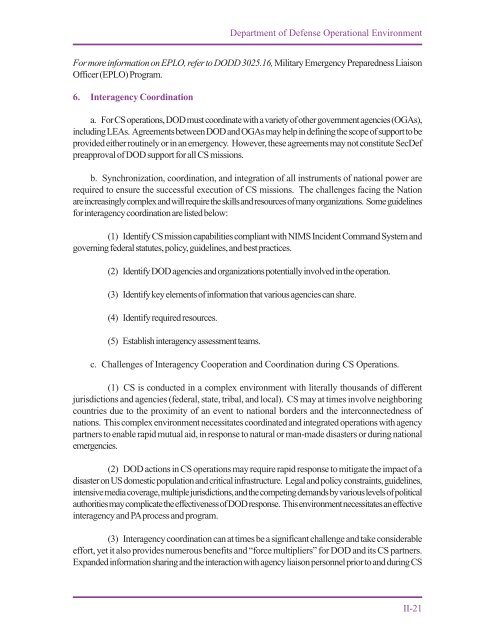JP 3-28, Civil Support - Federation of American Scientists
JP 3-28, Civil Support - Federation of American Scientists
JP 3-28, Civil Support - Federation of American Scientists
Create successful ePaper yourself
Turn your PDF publications into a flip-book with our unique Google optimized e-Paper software.
Department <strong>of</strong> Defense Operational Environment<br />
For more information on EPLO, refer to DODD 3025.16, Military Emergency Preparedness Liaison<br />
Officer (EPLO) Program.<br />
6. Interagency Coordination<br />
a. For CS operations, DOD must coordinate with a variety <strong>of</strong> other government agencies (OGAs),<br />
including LEAs. Agreements between DOD and OGAs may help in defining the scope <strong>of</strong> support to be<br />
provided either routinely or in an emergency. However, these agreements may not constitute SecDef<br />
preapproval <strong>of</strong> DOD support for all CS missions.<br />
b. Synchronization, coordination, and integration <strong>of</strong> all instruments <strong>of</strong> national power are<br />
required to ensure the successful execution <strong>of</strong> CS missions. The challenges facing the Nation<br />
are increasingly complex and will require the skills and resources <strong>of</strong> many organizations. Some guidelines<br />
for interagency coordination are listed below:<br />
(1) Identify CS mission capabilities compliant with NIMS Incident Command System and<br />
governing federal statutes, policy, guidelines, and best practices.<br />
(2) Identify DOD agencies and organizations potentially involved in the operation.<br />
(3) Identify key elements <strong>of</strong> information that various agencies can share.<br />
(4) Identify required resources.<br />
(5) Establish interagency assessment teams.<br />
c. Challenges <strong>of</strong> Interagency Cooperation and Coordination during CS Operations.<br />
(1) CS is conducted in a complex environment with literally thousands <strong>of</strong> different<br />
jurisdictions and agencies (federal, state, tribal, and local). CS may at times involve neighboring<br />
countries due to the proximity <strong>of</strong> an event to national borders and the interconnectedness <strong>of</strong><br />
nations. This complex environment necessitates coordinated and integrated operations with agency<br />
partners to enable rapid mutual aid, in response to natural or man-made disasters or during national<br />
emergencies.<br />
(2) DOD actions in CS operations may require rapid response to mitigate the impact <strong>of</strong> a<br />
disaster on US domestic population and critical infrastructure. Legal and policy constraints, guidelines,<br />
intensive media coverage, multiple jurisdictions, and the competing demands by various levels <strong>of</strong> political<br />
authorities may complicate the effectiveness <strong>of</strong> DOD response. This environment necessitates an effective<br />
interagency and PA process and program.<br />
(3) Interagency coordination can at times be a significant challenge and take considerable<br />
effort, yet it also provides numerous benefits and “force multipliers” for DOD and its CS partners.<br />
Expanded information sharing and the interaction with agency liaison personnel prior to and during CS<br />
II-21

















